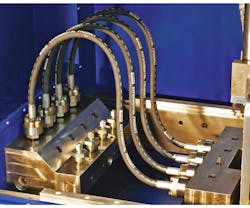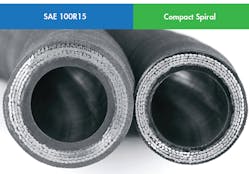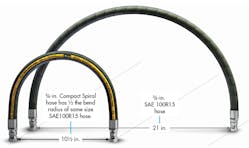This file type includes high resolution graphics and schematics when applicable.
For decades, SAE J517 has published guidelines for 100R1 through 100R12 series hydraulic hoses. These manufacturer-driven SAE standards have been based on design, construction, and pressure ratings to ensure that hydraulic hoses meet minimum construction requirements. They established minimum pressure ratings for various hose IDs (inside diameters) and were later revised to also include constant-pressure hoses—such as R13, R15, R17, and R19, where pressure rating remains constant within a group regardless of size.
More recently, however, hydraulic system designers began adopting ISO specifications. Many large OEMs switched to ISO standards in their design and manufacturing processes to ensure the sale and service of their equipment globally. Released in 2006, ISO Standard 18752 for hydraulic hose is relatively new to North American manufacturers.
ISO Standard 18752 takes a different approach, reflecting the design practices of users who typically design hydraulic systems based on performance and pressure requirements. Hydraulic hoses are classified in ISO 18752 according to their resistance to impulse pressure in four Grades: A, B, C, and D. Each Grade is then classified by the outside diameter (OD) of the hose into Standard Types (AS, BS, CS) or Compact Types (AC, BC, CC, DC).
Each grade level requires a specific number of impulse cycles the hose must meet at a specified temperature and impulse pressure. Parker’s new 787TC and 797TC series hoses—rated 35.0 MPa (5,000 psi) and 42.0 MPa (6,000 psi) constant pressure, respectively—not only meet the minimum 1 million cycles required in Grade D, Type DC, but have been successfully tested to 2 million impulse cycles at bend radii smaller than those required by ISO 18752.
Same ID, Smaller OD
The inside diameter of the 787TC and 797TC hoses is the same as common SAE spiral hoses. However, its OD is smaller, which makes the compact hose easier to fit into tight spaces and—perhaps more importantly—lets you bend it to a smaller bend radius with no decrease in pressure rating or life, and with less required bending force.
Key to the design success of the Compact Spiral hose is a proprietary Nitrile-based inner tube compound that is both stronger and thinner than what has been traditionally used in standard spiral hose. The overall strength properties of the new inner tube compound are such that it is possible to have the same ID, yet reduce the overall OD and size without sacrificing the pressure and sealing capabilities. In addition, the reduced tube wall thickness provided the opportunity to proportionally redesign the wire reinforcement, which led to an additional reduction in the hose OD.
The result is shown in the photo comparing cross sections of 1-in. (–16) SAE standard hose and the Compact Spiral hose. This means designers may be able to specify the next size larger hose—for lower fluid velocity and pressure drop—without needing more room for a larger hose. However, specifying the same size hose reduces outside diameter of the hose, the required bend radius, and the required bend force, ultimately making hose installation easier and quicker.
Traditional spiral hydraulic hose is stiff and heavy, often requiring two people to push and bend it into position. However, because Compact Spiral hose more flexible and weighs less, installation is faster and easier.
Testing for Toughness
The primary concept behind ISO Standard 18752 requires constant pressure performance ratings in each class for different hose sizes. ISO 18752 also requires spiral hose to exceed one million pressure impulse cycles according to ISO 18752 hose grade D, type DC. This requirement is the toughest of all grades and classes to achieve, and specifies meeting 120°C temperature and an impulse pressure of 133% of maximum working pressure for at least one million impulse cycles.
In this accelerated test, the hose is positioned into a U shape on a test stand, and the fluid is raised to the specified working pressure. Pressure pulses are also applied at an elevated value to stress the spiral wires and end fittings for the minimum number of required cycles. Parker has tested the new 787TC and 797TC Compact Spiral hoses to two million cycles as proof that the hose provides double the life of what is required in the ISO standard.
ISO 18752 Standard has nine pressure classes for maximum working pressure, ranging from 500 to 8,000 psi. Although SAE or international standards do not require conducting tests with hoses moving, Parker also tested the 787TC and 797TC flexed the hoses under movement while impulse pressure cycles were applied. The results demonstrate the performance and longevity of the hose.
Greg Reardon is business development manager at Parker Hannifin’s Hose Products Div., Wickliffe, Ohio. Click here for more information on Parker’s Compact Spiral hose.
Looking for parts? Go to SourceESB.
This file type includes high resolution graphics and schematics when applicable.





